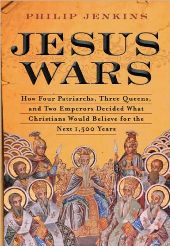
Jesus Wars: How Four Patriarchs, Three Queens, and Two Emperors Decided What Christians Would Believe for the Next 1,500 years
by Philip Jenkins
–Reviewed by Ralph Walter
 The difficult but critical doctrine that Jesus Christ is two different reflections of the same phenomenon – fully God and fully man in one being – was developed during late antiquity. It is one of that period’s great intellectual achievements, one that determined who Jesus Christ was, who he is today, and who he will be. Jesus Wars tells, in an approachable and exciting way, how that achievement came to be. Jenkins, himself of a liberal protestant bent, shows the story of the advancement, adoption and defense of the dogma to be one of politics, power, and corruption as much as it is one of theology.
The difficult but critical doctrine that Jesus Christ is two different reflections of the same phenomenon – fully God and fully man in one being – was developed during late antiquity. It is one of that period’s great intellectual achievements, one that determined who Jesus Christ was, who he is today, and who he will be. Jesus Wars tells, in an approachable and exciting way, how that achievement came to be. Jenkins, himself of a liberal protestant bent, shows the story of the advancement, adoption and defense of the dogma to be one of politics, power, and corruption as much as it is one of theology.
Jesus left no known writings or explanations. After he was hauled off by the Romans to be nailed to a tree, his immediate followers believed that he returned from the grave and appeared to them. They decided that scripture had been fulfilled and started to spread their gospel, literally, the “good news.” By the beginning of the fourth century, Constantine – convinced that the story of Christian hope was what he needed to revitalize his empire – adopted Christianity, as it had come to be called.
To Constantine’s surprise, the Christians in his empire professed many different sets of beliefs. He gathered their leaders at Nicaea in 325, where they agreed that their one God has three inseparable personae: the Father who creates, the Son who redeems, and the Holy Ghost who sustains. But for over a century the question remained, was Jesus Christ a man, a God, or a bit of both? In 451, at Chalcedon, it was “agreed” that he has two full natures in one undivided person. Unfortunately, the answer didn’t satisfy about half of the Christian world at the time. The Nestorians – numerous then, limited to a few enclaves today, mainly in northern Iraq – believed that two natures existed in Jesus Christ, but that they weren’t in complete union. The Monophysites argued for one nature with divine and human aspects, a view that continues to hold sway in Armenian, Coptic, and Syrian churches today, leading Jenkins to claim that the Monophysites in the region preferred benign Islamic rule to repression by fellow Christians.
The story of how the church got to Chalcedon and struggled afterwards is Jenkin’s theme. He has a great cast of characters: wild bishops, plotting Popes, harpy empresses, Machiavellian patriarchs, and militant rioting monks. Jenkins spins them into a good yarn, a tale of theological sausage-making, demonstrating that one of the most fundamental Christian principles was the creation of flawed men acting for less than noble reasons.
Further Reading: The Early Church (The Penguin History of the Church) (v. 1) by Henry Chadwick and Nicaea and Its Legacy: An Approach to Fourth-Century Trinitarian Theology
by Lewis Ayres.
Ralph Walter is a member of the Zócalo board of directors and lay episcopal minister.
*Photo courtesy Fergel OP.




Send A Letter To the Editors